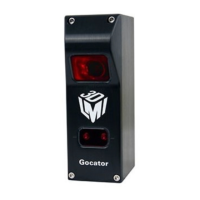Gocator Snapshot Sensors: User Manual
Gocator Web Interface • 76
The top-right of the Trigger panel displays the maximum speed at which an object could be captured at,
calculated based on the exposure values, active area and the number of projection patterns required.
The sensor can be triggered by one of the sources described in the table below.
If the sensor is connected to a Master 400 or higher, encoder and digital (external) input signals
over the IOcordset are ignored. The sensor instead receives these signals from the Master; for
encoder and digital input pinouts on Masters, see the section corresponding to your Master in
Master Network Controllers on page 536.
If the sensor is connected to a Master 100 (or no Master is used), the sensor receives signals
over the IOcordset. For information on connecting encoder and digital input signals to a sensor
in these cases, see Encoder Input on page 534Digital Input on page 533Encoder Input on page
534
Trigger Source Description
Time
Sensors have an internal clock that can be used to generate fixed-frequency triggers. The
external input can be used to enable or disable the time triggers.
External Input
A digital input can provide triggers in response to external events (e.g., photocell). The external
input triggers on the rising edge of the signal.
When triggers are received at a frequency higher than the maximum frame rate, some triggers
may not be accepted. The Trigger Drops Indicator in the Dashboard page can be used to check
for this condition.
For information on the maximum input trigger rate, see Maximum Input Trigger Rate on page 79.
Software
A network command can be used to send a software trigger. See Protocols on page 387 for more
information.
Depending on the setup and measurement tools used, the CPU utilization may exceed 100%, which
reduces the overall acquisition speed. If the Clear Calibration button is pressed, the calibration will be
erased and the sensor will revert to using sensor coordinates. For the estimated acquisition speeds
under different settings, see Estimated Scan Rates on page 528.
For examples of typical real-world scenarios, see Trigger Examples on the next page. For information on
the settings used with each trigger source, see Trigger Settings on page 78
